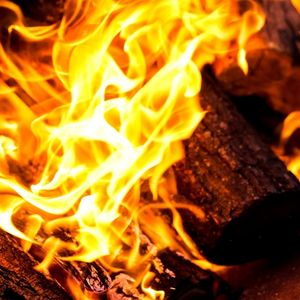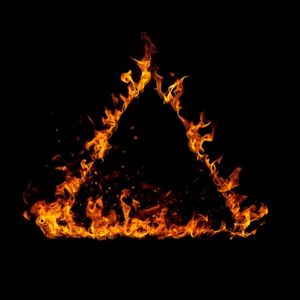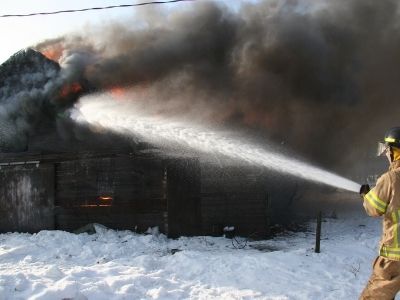Fire is an unusual substance in that it is difficult to explain exactly what it is. Fire does also appear to be alive and to have a mind of its own at times, but can we call it a living thing. Does fire grow and have cells like other living beings? Or is there something else going on here?
Fire does not have cells as it is not a living thing or biological organism. There is no reproduction of biological cells through organic growth. However, fire appears to “grow” as it spreads from its initial source.

Also, organic matter dies at a cellular level, whereas fire is simply extinguished. Fire may be completely different in its composition and make-up, but there is still a strong relationship between fire and organic cellular matter.
Fire is an interesting thing that is so hard to classify. We tend to label physical things as natural or man-made, as animal, vegetable, or mineral in origin, or as a gaseous, solid, or liquid state. Fire is so unique that we struggle to know where to put it. So, to better understand why fire isn’t a living thing, and what it actually is, we need to look at the following factors.
- What cells are and why they are so essential to living creatures
- How fire is created and how this has no relation to organic matter
- Organic life as animal or vegetable matter vs the chemical reaction of fire
- Cell death vs fire extinguishment
Table of Contents
Is fire alive?
We tend to talk about fire as though it were a living being, such as referring to dancing flames in a fireplace or to feeding flames with more fuel.
There is also the sense that the increased intensity of a fire and its movement is determined by the fire itself as it is out of our control. However, there are other factors at work controlling what happens to the fire and many of these are man-made.
We control the amount of fuel added to a blaze and when to take away a crucial component to extinguish it. We can easily create fire with the right tools and conditions, but we aren’t giving life to it.

There is also the fact that it is difficult to label a fire under common categories of animal, vegetable, or mineral, or those of solid, gaseous, or liquid states.
Fire burns a solid animal, vegetable, or mineral material and converts it to energy. It can then create a smoke that is solid in part through ash but can also have some gaseous and liquid elements.
What are cells?
Cells are vital components for all living organisms. It doesn’t matter our species or form, we all come down to very similar cellular structures.
These cells come in various forms depending on their purpose within the body.
But they all contain a nucleus with vital genetic information, a cytoplasm that is basically a soup of different components necessary for the cell to perform its function, and then a membrane to keep it all together.
The cells have a distinct purpose and use the energy we burn from food to maintain healthy and productive functions.
How is fire created?
Fire is different as you have a chemical reaction rather than organic growth from multiplying cells.
Still, there is one small beginning to the creation of fire where the flames then “grow” at a rapid rate and develop into a fire.
All it takes is a spark of energy and the right combination of heat, oxygen, and an appropriate fuel source.
We call this trio of factors the fire triangle and that triangle is responsible for the generation of fire in all cases.
A good example of how this works is a simple match. Matches are an easy way to create fire and then light items like gas stoves or candles. The match has a chemical fuel in the head, the friction against the side of the matchbox creates heat, and there is oxygen in the air.
The combination of the three creates that instant flame. There is no need for living cells to provide the fuel needed for life as there isn’t that complex delivery system from food to energy. Fuel is constant and continually consumed at the source by the flames.
While fire and living matter is very different, interestingly, there is a link here between the viability of both. Both fire and living cells require oxygen to thrive.

Cellular respiration is a vital process where cells use the oxygen gathered to break down the energy in the sugars taken up through food. Therefore, it is all about oxygen and fuel, just like those flames.
As long as there is a strong supply of fuel to the cell and enough oxygen to break it down, the cell should be able to function as normal.
How does fire spread?
That “birth” of fire starts with the ignition of the flame from those three important components. As long as those aspects of the fire triangle remain in place, the fire should start to “grow” and expand in size.
It is all about providing enough fuel to burn and maintaining the temperature and oxygen levels. Fire tends to increase in size in a landscape or a structure fire when it encounters additional flammable material.
- A controlled campfire will reach its limit quite quickly based on the material in the fire and additional firewood added if the fire looks like it is struggling to maintain its intensity. The same is true for stoked fireplaces with appropriate materials at hand.
- A wildfire will grow as the flames encounter more vegetation to burn and progress until it is driven back, extinguished, or burns itself out.
- A house fire will burn through flammable materials in the basic structure of the home, soft furnishings, and more.
- Industrial fires could increase in size very quickly if there are large quantities of dangerous chemicals or explosives in a small facility.
Either way, it isn’t about the make-up of the fire itself but what it can consume to create a bigger reaction. This isn’t the case with organic matter, where growth and energy are important.
Here the cells can multiply to grow and replicate themselves when old cells die. Cell multiplication is also a form of division, where cells duplicate contents and divide the matter into new cells.
This process starts from the moment a single-celled egg is fertilized by sperm for the creation of an embryo. There is no physical matter within fire that can multiply like this.
Cell death and the death of organic matter
Cells multiply for growth and go through all those complicated processes to sustain life. But, at some point, these cells will also die.
Cells die all the time within the human body, but it does us little harm and makes little difference to us because they are replenished with new cells and this is all on an internal and microscopic level. Dry skin is dead cells but we develop a fresh layer.
However, rapid cell death can be more dangerous and potentially fatal. Necrosis can cause cell membranes to rupture and no longer fulfill their role.
This can lead to infections and inflammation on a low level but more serious complications where necrosis is rapid and has no chance for regeneration.
Again, we come back to the importance of that relationship between fuel and air. When cells are starved of oxygen and fuel, they cannot function and will eventually die.
This process can take a while depending on the oxygen levels in the body.

For example, a person or animal could be technically dead with no heartbeat or breathing function, but the cells may remain alive for a little while longer. It isn’t until much later that all the cells will die and the decomposition process can begin.
This is when enzymes break the cells down and reduce organic matter back into energy.
Fire “death” through extinguishing the flames.
We can’t kill fire in the same way that organic matter dies. There is no living cell that no longer becomes viable. Instead, we extinguish the fire and destroy that fire triangle so it cannot continue to burn.
Extinguishing fires comes from the removal of one or more of the key elements mentioned above. This could be the oxygen necessary to keep the fire intact, the fuel supply for it to burn, or the temperature needed to sustain the process.
Removing fuel supplies isn’t always easy, although some fires will burn themselves out this way. Removing oxygen is easier with the right tools to smother the flames.
Or, you could use water to cool down the fire and control it that way.
To summarize, fire itself does not have cells as it is not organic matter that grows like an animal or vegetable form.
Instead, it spread through an acceleration of a chemical reaction between the heat, oxygen, and the fuel source. Fire may burn the cells of organic matter to stay “alive” but this doesn’t lead to the generation of cells.
Fire is just a chemical reaction, but one that is unique and influential in the life and death of cellular matter.